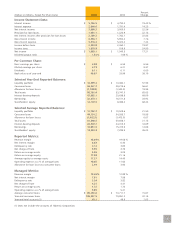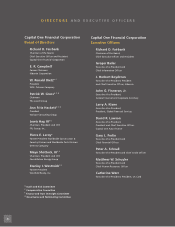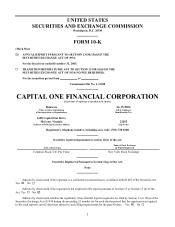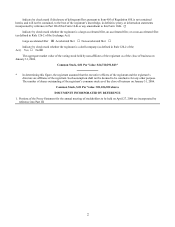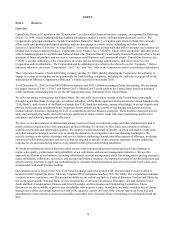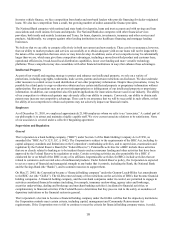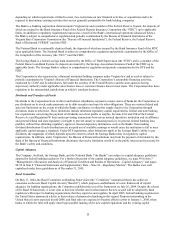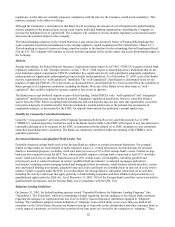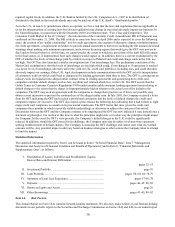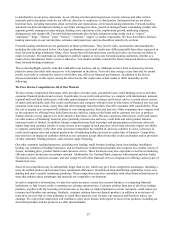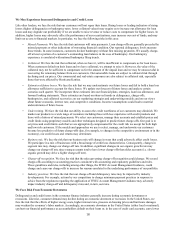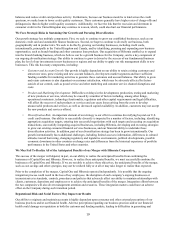Capital One 2005 Annual Report Download - page 18
Download and view the complete annual report
Please find page 18 of the 2005 Capital One annual report below. You can navigate through the pages in the report by either clicking on the pages listed below, or by using the keyword search tool below to find specific information within the annual report.Capital One’ s business strategies and activities. The management of reputation risk is overseen by the Executive Vice
President of Corporate Reputation and Governance with the advice and guidance of the Reputation Risk Management Team
housed in the Corporate Affairs Department. The Company uses qualitative criteria to assess reputation risk. Various
measures, both internal and external, are considered to gauge changes to the Company’ s reputation and overall reputation risk
and include brand market research, customer studies, internal operational loss event data and external measures.
Compliance Risk Management
Compliance risk is the risk of non-conformance to laws, rules and regulations. The management of compliance risk is
overseen by the Chief Compliance Officer with the advice and guidance of the ERM Committee. The corporate compliance
organization, a part of the ERM department, provides the business areas with consulting, training and assistance in the
implementation of business processes to ensure compliance with applicable laws and regulations. The business areas assess
compliance risk through the Company’ s enterprise risk self assessment process and conduct monitoring and remediation
activities for which the compliance organization establishes standards.
Technology / Systems
We leverage information technology to achieve our business objectives and to develop and deliver products and services that
satisfy our customers’ needs. A key part of our strategic focus is the development of efficient, flexible computer and
operational systems to support complex marketing and account management strategies and the development of new and
diversified products. Our commitment to managing risk and ensuring effective controls is built into all of our strategies. We
believe that the continued development and integration of these systems is an important part of our efforts to reduce costs,
improve quality and provide faster, more flexible technology services. Consequently, we continuously review capabilities
and develop or obtain systems, processes and competencies to meet our unique business requirements. As part of our
continuous efforts to review and improve our technologies, we may either develop such capabilities internally or rely on third
party outsourcers who have the ability to deliver technology that is of higher quality, lower cost, or both. Over time, we have
increasingly relied on third party outsourcers to help us deliver systems and operational infrastructure. Consistent with this
approach, in August 2005 Capital One and Total System Services Inc. (“TSYS ”) finalized a five year definitive
agreement for TSYS to provide processing services for Capital One’ s North American portfolio of consumer and small
business credit card accounts. The Company believes that its transfer to this new technology platform will allow it to achieve
ost savings and product and service flexibility while reducing operational risk.
c
unding and Liquidity F
A discussion of our funding programs and liquidity has been included in Item 7 “Management’ s Discussion and Analysis of
Financial Condition and Results of Operations—Funding” on pages 43-47.
C
ompetition
Each of our credit card and other financial products is marketed to specific consumer populations across the credit spectrum.
The terms of each product are actively managed to achieve a balance between risk and expected performance. For example,
credit card product terms typically include the ability to reprice individual accounts upwards or downwards based on the
customer’ s payment and other performance. In addition, since 1998, we have marketed low non-introductory rate cards to
consumers with low-risk and established credit profiles to take advantage of the favorable risk return characteristics of this
consumer type. Industry competitors have continuously solicited our customers with these and other interest rate strategies.
Management believes the competition has put, and will continue to put, additional pressure on our pricing and general
product feature strategies.
As a marketer of credit card and other financial products, we face intense competition in all aspects of our business from
numerous bank and non-bank providers of financial services. Some of these companies are substantially larger and have more
resources than we do. In addition, our industry has experienced substantial consolidation and may continue to do so; this
consolidation continues to create competitors who are larger and have more resources than we do. In addition, such
consolidated and/or larger competitors may have a more diversified product and customer base, operational efficiencies and
more versatile technology platforms than we do. Consolidation has, and may continue, to increase competitive pressures on
both us and other companies in our industry.
We compete with international, national, regional and local issuers of Visa® and MasterCard® credit cards. In addition,
American Express®, Discover Card® and, to a certain extent, smart cards and debit cards, represent additional competition to
the general purpose credit card. In general, customers are attracted to credit card issuers largely on the basis of price, credit
limit and other product features, and customer loyalty is often limited.
9


